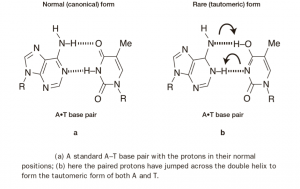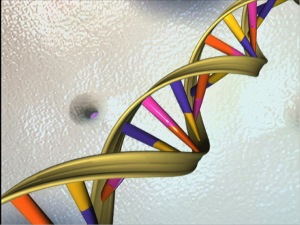Proton Tunnelling in DNA Mutation
One of the most peculiar features of life is that every heritable feature of every living organism including ourselves, from the colour of our hair to the shape of our nose, our propensity for disease, even aspects of our personality, are encoded by a single molecule of DNA. Single molecules are necessarily quantum mechanical so our genes are written in a quantum code made up of a linear array of protons along the double helix. Nothing else in the visible world is so connected to quantum realm.
In his book, ‘What is Life?’ Erwin Schrödinger suggested that mutations may be a kind of quantum jump. In their classic DNA paper, Watson and Crick went on to propose that they may involve nucleotide bases switching between alternative structures, a process called tautomerization that may involve quantum tunnelling.
Tautomerization involves the motion of coding protons into the ‘wrong’ position in DNA, where they may cause mutations. Tautomerisation may be caused by classical energetic hopping of the proton from one place in the DNA strand to another but it may also be caused by quantum tunnelling. But these different positions for the coding protons correspond to different DNA codes. So, if protons can tunnel to alternative position then, at the quantum mechanical level, DNA may exist in a superposition of mutational states corresponding to different genetic codes.

In 1999, Jim Al-Khalili and I suggested that proton tunnelling might account for peculiar form of mutations called adaptive mutations that appeared to occur more frequently when they provided an advantage.
McFadden, JJ and Al-Khalili (1999). Biosystems 50: 203-211
Our paper was entirely theoretical but we are currently attempting to find experimental evidence for proton tunnelling in DNA.

